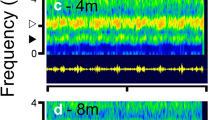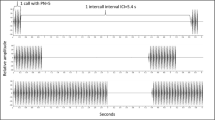Summary
-
1.
Distances between calling maleMygalopsis marki Bailey (Orthoptera: Tettigoniidae) were measured in two geographically distinct populations. Mean intermale distances differed significantly in the two habitats (6.2 m and 11.5 m), but the sound pressure level of the nearest neighbour, measured at each focal male, was close to 65 dB SPL in both populations (Figs. 4, 6).
-
2.
Using the response of an identified auditory interneuron as a ‘biological microphone’, the maximum hearing distance of males was tested. It was found to be affected by the size of the calling male, its posture, perch height and the vegetation density. Perch height alone influenced the maximum broadcast area of males by some 100%. Nearest neighbour distances were less than half the maximum hearing distances, confirming by neurophysiological methods that males do not space on threshold sensitivity to the complete call (Fig. 5).
-
3.
The ability of the bushcricket to perceive the temporal characteristic of the call was also tested with the auditory interneuron over increasing distances from a signaller. The temporal integrity of the song was found to be maintained over the whole broadcasting area (Fig. 9).
-
4.
The call has two energy peaks at 10 kHz and 20 kHz. The intensity of each peak attenuated differentially with increasing distance from the signaller; the low frequency component had a low variance at the nearest neighbour distance (SD: +4 dB/−6 dB) compared to the high frequency component (SD: +5 dB/−12.5 dB) (Fig. 8). The importance of the total sound pressure level and the relative intensity of the major frequency components of the song are discussed in relation to likely cues available to the male for maintaining spacing.
Similar content being viewed by others
References
Abrams TW, Pearson KG (1982) Effects of temperature on identified central neurons that control jumping in the grasshopper. J Neurosci 2:1538–1553
Alexander RD (1975) Natural selection and specialized chorusing behavior in acoustical insects. In: Pimental D (ed) Insects, science and society. Academic Press, New York, pp 35–77
Bailey WJ (1979) A review of the Australian Copiphorini (Orthoptera: Tettigoniidae: Conocephalinae). Aust J Zool 27:1015–1049
Bailey WJ (1985) Acoustic cues for female choice in bushcrickets (Tettigoniidae). In: Kalmring K, Elsner N (eds) Acoustic and vibrational communication in insects. Parey, Berlin Hamburg, pp 101–111
Bailey WJ, Thiele DR (1983) Male spacing behavior in the Tettigoniidae: An experimental approach. In: Gwynne DT, Morris GK (eds) Orthopteran mating systems. Sexual competition in a diverse group of insects. Westview Press, Boulder, Colorado, pp 163–184
Bennet-Clark HC (1984) Insect hearing: Acoustics and transduction. In: Lewis T (ed) Insect communication. Academic Press, New York London, pp 49–82
Brenowitz EA (1982) The active space of red-winged blackbird song. J Comp Physiol 147:511–522
Brenowitz EA, Wilczynski W, Zakon HH (1984) Acoustic communication in spring peepers. Environmental and behavioral aspects. J Comp Physiol A 155:585–592
Burkhardt D (1959) Die Erregungsvorgänge sensibler Ganglienzellen in Abhängigkeit von der Temperatur. Biol Zentralbl 78:22–62
Campbell DJ, Clarke DJ (1971) Nearest neighbour tests of significance for non-randomness in the spatial distribution of singing crickets (Teleogryllus commodus (Walker)). Anim Behav 19:750–756
Campbell DJ, Shipp E (1979) Regulation of spatial pattern in populations of the field cricketTeleogryllus commodus (Walker). Z Tierpsychol 51:260–268
Clark PJ, Evans FC (1954) Distance to nearest neighbour as a measure of spatial relationships in populations. Ecology 35:445–453
Dadour IR, Johnson MS (1983) Genetic differentiation, hybridization and reproductive isolation inMygalopsis marki Bailey (Orthoptera: Tettigoniidae). Austr J Zool 31:353–360
Elsner N (1974) Neuroethology of sound production in gomphocerine grasshoppers (Orthoptera: Acrididae) I. Song patterns and stridulatory movements. J Comp Physiol 88:67–102
Elsner N, Popov AV (1978) Neuroethology of acoustic communication. Adv Insect Physiol 13:229–355
Gerhardt HC (1975) Sound pressure levels and radiation patterns of the vocalizations of some North American frogs and toads. J Comp Physiol 102:1–12
Gerhardt HC (1983) Communication and the environment. In: Halliday TR, Slater PJB (eds) Communication. Oxford, Blackwell Scientific Publ, pp 83–113
Greenfield MD, Shaw KC (1983) Adaptive significance of chorusing with special reference to the Orthoptera. In: Gwynne DT, Morris GK (eds) Orthopteran mating systems. Sexual competition in a diverse group of insects. Westview Press, Boulder, Colorado, pp 1–27
Heitler WJ, Goodman CS, Rowell CHF (1977) The effects of temperature on the threshold of identified neurons in the locust. J Comp Physiol 117:163–182
Hill KG (1974) Acoustic communication in the Australian field cricketsTeleogryllus commodus andT. oceanicus. PhD thesis, Dept Zool, Melbourne, Australia
Hill KG, Boyan GS (1977) Sensitivity of frequency and direction of sound in the auditory system of crickets (Gryllidae). J Comp Physiol 121:79–97
Hubl L, Schneider H (1979) Temperature and auditory thresholds: bio-acoustic studies of the frogsRana ridibunda, Hyla arborea andHyla savignyi (Anura, Amphibia). J Comp Physiol 130:17–27
Latimer W (1980) Song and spacing inGampsocleis glabra. J Natl Hist 14:201–213
Lewis DB, Seymour C, Broughton WB (1975) The response characteristics of the tympanal organs of two species of bushcricket and some studies of the problem of sound transmission. J Comp Physiol 104:325–351
Littlejohn MJ, Martin AA (1969) Acoustic interaction between two species of leptodactylid frogs. Anim Behav 17:785–791
Marten K, Marler P (1977) Sound transmission and its significance for animal vocalization. Behav Ecol Sociobiol 2:271–290
Marten K, Quine D, Marler P (1977) Sound transmission and its significance for animal vocalization. II. Tropical forest habitats. Behav Ecol Sociobiol 2:291–302
Meixner AJ, Shaw KC (1979) Spacing and movement of singingNeoconocephalus nebrascensis males (Tettigoniidae: Copiphorinae). Ann Entomol Soc Am 72:602–606
Michelsen A (1978) Sound reception in different environments. In: Ali MA (ed) Sensory ecology. Plenum, New York London, pp 345–373
Michelsen A (1979) Insect ears as mechanical systems. Am Sci 67:696–706
Michelsen A, Larsen ON (1983) Strategies for acoustic communication in complex environments. In: Huber F, Markl H (eds) Neuroethology and behavioral physiology. Springer, Berlin Heidelberg New York Tokyo, pp 321–332
Michelsen A, Nocke H (1974) Biophysical aspects of sound communication in insects. Adv Insect Physiol 10:247–296
Moffat AJM, Capranica RR (1976) Effects of temperature on the response properties of auditory nerve fibres in the American toad (Bufo americanus). J Acoust Soc Am 60:580
Morris GK, Kerr GE, Gwynne DT (1975) Calling song function in the bog katydid,Metrioptera sphagnorum (F. Walker) (Orthoptera, Tettigoniidae): Female phonotaxis to normal and altered song. Z Tierpsychol 37:502–514
Morris GK, Kerr GE, Fullard JH (1977) Phonotactic preferences of female meadow katydids (Orthoptera: Tettigoniidae:Conocephalus migripleurum). Can J Zool 56:1479–1487
Oldfield BP (1984) Physiology of auditory receptors in two species of Tettigoniidae (Orthoptera: Ensifera): Alternative tonotopic organization of the auditory organ. J Comp Physiol A 155:689–696
Otte D, Joern A (1975) Insect territoriality and its evolution: population studies of desert grasshoppers on creosote bushes. J Anim Ecol 44:29–54
Rheinlaender J, Römer H (1980) Bilateral coding of sound direction in the CNS of the bushcricketTettigonia viridissima L. (Orthoptera, Tettigoniidae). J Comp Physiol 140:101–111
Rheinlaender J, Römer H (1986) Insect hearing in the field: I. The use of identified nerve cells as ‘biological microphones’. J Comp Physiol 158:647–652
Richards DG, Wiley RH (1980) Reverberations and amplitude fluctuations in the propagation of sound in a forest: implications for animal communication. Am Nat 115:381–399
Robertson JGM (1984) Acoustic spacing by breeding males ofUperoleia rugosa (Anura: Leptodactylidae). Z Tierpsychol 64:283–297
Römer H (1985) Anatomical representation of frequency and intensity in the auditory system of Orthoptera. In: Kalmring K, Elsner N (eds) Acoustic and vibrational communication in insects. Parey, Berlin Hamburg, pp 25–33
Schatral A, Latimer W, Broughton WB (1984) Spatial dispersion and agonistic contacts of male bush crickets in the biotope. Z Tierpsychol 65:201–214
Thiele DR (1981) Mechanisms of acoustic spacing within populations of the TettigoniidMygalopsis marki. PhD thesis, University of Western Australia
Thiele DR, Bailey WJ (1980) The function of sound in male spacing behaviour in bushcrickets (Tettigoniidae, Orthoptera). Aust J Ecol 5:275–286
Wiley RH, Richards DG (1978) Physical constraints on acoustic communication in the atmosphere: implications for the evolution of animal vocalizations. Behav Ecol Sociobiol 3:69–91
Wohlers DW, Huber F (1978) Intracellular recording and staining of cricket auditory interneurons (Gryllus campestris L.,Gryllus bimaculatus DeGeer). J Comp Physiol 127:11–28
Author information
Authors and Affiliations
Rights and permissions
About this article
Cite this article
Römer, H., Bailey, W.J. Insect hearing in the field. J. Comp. Physiol. 159, 627–638 (1986). https://doi.org/10.1007/BF00612036
Accepted:
Issue Date:
DOI: https://doi.org/10.1007/BF00612036




